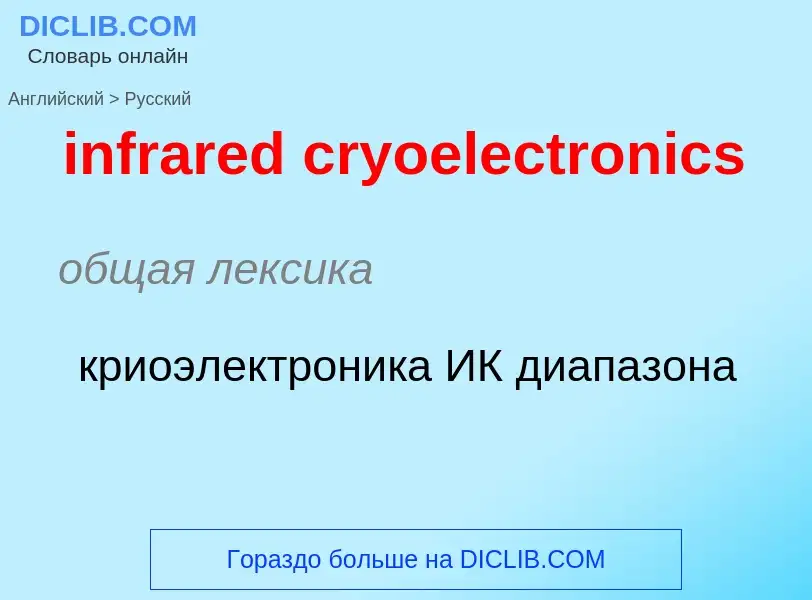Tradução e análise de palavras por inteligência artificial ChatGPT
Nesta página você pode obter uma análise detalhada de uma palavra ou frase, produzida usando a melhor tecnologia de inteligência artificial até o momento:
- como a palavra é usada
- frequência de uso
- é usado com mais frequência na fala oral ou escrita
- opções de tradução de palavras
- exemplos de uso (várias frases com tradução)
- etimologia
infrared cryoelectronics - tradução para russo
общая лексика
криоэлектроника ИК диапазона
общая лексика
связь в инфракрасной части спектра
Definição
Wikipédia

Infrared (sometimes called infrared light and IR) is electromagnetic radiation (EMR) with wavelengths longer than those of visible light and shorter than radio waves. It is therefore invisible to the human eye. IR is generally understood to encompass wavelengths from around 1 millimeter (300 GHz) to the nominal red edge of the visible spectrum, around 700 nanometers (430 THz). IR is commonly divided between longer wavelength thermal infrared that is emitted from terrestrial sources and shorter wavelength near-infrared that is part of the solar spectrum. Longer IR wavelengths (30 μm-100 μm) are sometimes included as part of the terahertz radiation range. Almost all black-body radiation from objects near room temperature is at infrared wavelengths. As a form of electromagnetic radiation, IR propagates energy and momentum, exerts radiation pressure, and has properties corresponding to both those of a wave and of a particle, the photon.
It was long known that fires emit invisible heat; in 1681 the pioneering experimenter Edme Mariotte showed that glass, though transparent to sunlight, obstructed radiant heat. In 1800 the astronomer Sir William Herschel discovered that infrared radiation is a type of invisible radiation in the spectrum lower in energy than red light, by means of its effect on a thermometer. Slightly more than half of the energy from the Sun was eventually found, through Herschel's studies, to arrive on Earth in the form of infrared. The balance between absorbed and emitted infrared radiation has an important effect on Earth's climate.
Infrared radiation is emitted or absorbed by molecules when changing rotational-vibrational movements. It excites vibrational modes in a molecule through a change in the dipole moment, making it a useful frequency range for study of these energy states for molecules of the proper symmetry. Infrared spectroscopy examines absorption and transmission of photons in the infrared range.
Infrared radiation is used in industrial, scientific, military, commercial, and medical applications. Night-vision devices using active near-infrared illumination allow people or animals to be observed without the observer being detected. Infrared astronomy uses sensor-equipped telescopes to penetrate dusty regions of space such as molecular clouds, to detect objects such as planets, and to view highly red-shifted objects from the early days of the universe. Infrared thermal-imaging cameras are used to detect heat loss in insulated systems, to observe changing blood flow in the skin, to assist firefighting, and to detect the overheating of electrical components.
Military and civilian applications include target acquisition, surveillance, night vision, homing, and tracking. Humans at normal body temperature radiate chiefly at wavelengths around 10 μm (micrometers). Non-military uses include thermal efficiency analysis, environmental monitoring, industrial facility inspections, detection of grow-ops, remote temperature sensing, short-range wireless communication, spectroscopy, and weather forecasting.


![Active-infrared night vision: the camera illuminates the scene at infrared wavelengths invisible to the [[human eye]]. Despite a dark back-lit scene, active-infrared night vision delivers identifying details, as seen on the display monitor. Active-infrared night vision: the camera illuminates the scene at infrared wavelengths invisible to the [[human eye]]. Despite a dark back-lit scene, active-infrared night vision delivers identifying details, as seen on the display monitor.](https://commons.wikimedia.org/wiki/Special:FilePath/Active-Infrared-Night-Vision.jpg?width=200)
![Infrared light from the [[LED]] of a [[remote control]] as recorded by a digital camera Infrared light from the [[LED]] of a [[remote control]] as recorded by a digital camera](https://commons.wikimedia.org/wiki/Special:FilePath/Blue infrared light.jpg?width=200)
![[[Beta Pictoris]] with its planet Beta Pictoris b, the light-blue dot off-center, as seen in infrared. It combines two images, the inner disc is at 3.6 μm. [[Beta Pictoris]] with its planet Beta Pictoris b, the light-blue dot off-center, as seen in infrared. It combines two images, the inner disc is at 3.6 μm.](https://commons.wikimedia.org/wiki/Special:FilePath/ESO - Beta Pictoris planet finally imaged (by).jpg?width=200)
![Materials with higher [[emissivity]] appear closer to their true temperature than materials that reflect more of their different-temperature surroundings. In this thermal image, the more reflective ceramic cylinder, reflecting the cooler surroundings, appears to be colder than its cubic container (made of more emissive silicon carbide), while in fact, they have the same temperature. Materials with higher [[emissivity]] appear closer to their true temperature than materials that reflect more of their different-temperature surroundings. In this thermal image, the more reflective ceramic cylinder, reflecting the cooler surroundings, appears to be colder than its cubic container (made of more emissive silicon carbide), while in fact, they have the same temperature.](https://commons.wikimedia.org/wiki/Special:FilePath/Effect of emissivity on apparent temperature.jpg?width=200)
![hair salons]], c. 2010s hair salons]], c. 2010s](https://commons.wikimedia.org/wiki/Special:FilePath/Hooded dryer for infrared hair drying at hair salon - shown from three perspectives.jpg?width=200)

![An infrared reflectogram of ''[[Mona Lisa]]'' by [[Leonardo da Vinci]] An infrared reflectogram of ''[[Mona Lisa]]'' by [[Leonardo da Vinci]]](https://commons.wikimedia.org/wiki/Special:FilePath/Infrared reflectograms of Mona Lisa.jpg?width=200)
![IR satellite picture of cumulonimbus clouds over the [[Great Plains]] of the United States. IR satellite picture of cumulonimbus clouds over the [[Great Plains]] of the United States.](https://commons.wikimedia.org/wiki/Special:FilePath/NOAA Shares First Infrared Imagery from GOES-17 (43904870711).gif?width=200)
![Thermography helped to determine the temperature profile of the [[Space Shuttle thermal protection system]] during re-entry. Thermography helped to determine the temperature profile of the [[Space Shuttle thermal protection system]] during re-entry.](https://commons.wikimedia.org/wiki/Special:FilePath/STS-3 infrared on reentry.jpg?width=200)

![false-color]] infrared space telescope image has blue, green and red corresponding to 3.4, 4.6, and 12 [[μm]] wavelengths, respectively. false-color]] infrared space telescope image has blue, green and red corresponding to 3.4, 4.6, and 12 [[μm]] wavelengths, respectively.](https://commons.wikimedia.org/wiki/Special:FilePath/Wide-field Infrared Survey Explorer first-light image.jpg?width=200)

